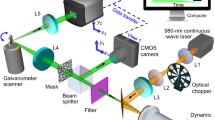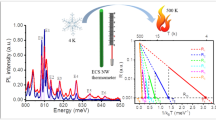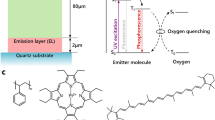Abstract
Although metal-halide perovskites have recently revolutionized research in optoelectronics through a unique combination of performance and synthetic simplicity, their low-dimensional counterparts can further expand the field with hitherto unknown and practically useful optical functionalities. In this context, we present the strong temperature dependence of the photoluminescence lifetime of low-dimensional, perovskite-like tin-halides and apply this property to thermal imaging. The photoluminescence lifetimes are governed by the heat-assisted de-trapping of self-trapped excitons, and their values can be varied over several orders of magnitude by adjusting the temperature (up to 20 ns °C−1). Typically, this sensitive range spans up to 100 °C, and it is both compound-specific and shown to be compositionally and structurally tunable from −100 to 110 °C going from [C(NH2)3]2SnBr4 to Cs4SnBr6 and (C4N2H14I)4SnI6. Finally, through the implementation of cost-effective hardware for fluorescence lifetime imaging, based on time-of-flight technology, these thermoluminophores have been used to record thermographic videos with high spatial and thermal resolution.
This is a preview of subscription content, access via your institution
Access options
Access Nature and 54 other Nature Portfolio journals
Get Nature+, our best-value online-access subscription
$29.99 / 30 days
cancel any time
Subscribe to this journal
Receive 12 print issues and online access
$259.00 per year
only $21.58 per issue
Buy this article
- Purchase on Springer Link
- Instant access to full article PDF
Prices may be subject to local taxes which are calculated during checkout




Similar content being viewed by others
Data availability
The data that support the findings of this study are available from the corresponding authors upon reasonable request.
References
Lahiri, B. B., Bagavathiappan, S., Jayakumar, T. & Philip, J. Medical applications of infrared thermography: a review. Infrared Phys. Technol. 55, 221–235 (2012).
Jones, H. G. et al. Thermal infrared imaging of crop canopies for the remote diagnosis and quantification of plant responses to water stress in the field. Funct. Plant Biol. 36, 978–989 (2009).
Bagavathiappan, S., Lahiri, B. B., Saravanan, T., Philip, J. & Jayakumar, T. Infrared thermography for condition monitoring—a review. Infrared Phys. Technol. 60, 35–55 (2013).
Tang, X., Ackerman, M. M. & Guyot-Sionnest, P. Thermal imaging with plasmon resonance enhanced HgTe colloidal quantum dot photovoltaic devices. ACS Nano 12, 7362–7370 (2018).
Lhuillier, E., Keuleyan, S., Rekemeyer, P. & Guyot-Sionnest, P. Thermal properties of mid-infrared colloidal quantum dot detectors. J. Appl. Phys. 110, 033110 (2011).
Rogalski, A. Progress in focal plane array technologies. Prog. Quantum Electron. 36, 342–473 (2012).
Peterson, B. J. Infrared imaging video bolometer. Rev. Sci. Instrum. 71, 3696–3701 (2000).
Mykhaylyk, V. B., Wagner, A. & Kraus, H. Non-contact luminescence lifetime cryothermometry for macromolecular crystallography. J. Synchrotron Radiat. 24, 636–645 (2017).
Allison, S. W. & Gillies, G. T. Remote thermometry with thermographic phosphors: instrumentation and applications. Rev. Sci. Instrum. 68, 2615–2650 (1997).
Marciniak, L., Prorok, K., Frances-Soriano, L., Perez-Prieto, J. & Bednarkiewicz, A. A broadening temperature sensitivity range with a core–shell YbEr@YbNd double ratiometric optical nanothermometer. Nanoscale 8, 5037–5042 (2016).
Salem, M., Staude, S., Bergmann, U. & Atakan, B. Heat flux measurements in stagnation point methane/air flames with thermographic phosphors. Exp. Fluids 49, 797–807 (2010).
Alaruri, S. D., Brewington, A. J., Thomas, M. A. & Miller, J. A. High-temperature remote thermometry using laser-induced fluorescence decay lifetime measurements of Y2O3:Eu and YAG:Tb thermographic phosphors. IEEE Trans. Instrum. Meas. 42, 735–739 (1993).
Brübach, J., Pflitsch, C., Dreizler, A. & Atakan, B. On surface temperature measurements with thermographic phosphors: a review. Prog. Energy Combust. Sci. 39, 37–60 (2013).
Wang, X.-d, Wolfbeis, O. S. & Meier, R. J. Luminescent probes and sensors for temperature. Chem. Soc. Rev. 42, 7834–7869 (2013).
Brübach, J. et al. A survey of phosphors novel for thermography. J. Lumin. 131, 559–564 (2011).
Sun, T., Zhang, Z. Y., Grattan, K. T. V., Palmer, A. W. & Collins, S. F. Temperature dependence of the fluorescence lifetime in Pr3+:ZBLAN glass for fiber optic thermometry. Rev. Sci. Instrum. 68, 3447–3451 (1997).
Okabe, K. et al. Intracellular temperature mapping with a fluorescent polymeric thermometer and fluorescence lifetime imaging microscopy. Nat. Commun. 3, 705 (2012).
Abram, C., Fond, B. & Beyrau, F. Temperature measurement techniques for gas and liquid flows using thermographic phosphor tracer particles. Prog. Energy Combust. Sci. 64, 93–156 (2018).
Bhandari, A., Barsi, C. & Raskar, R. Blind and reference-free fluorescence lifetime estimation via consumer time-of-flight sensors. Optica 2, 965–973 (2015).
Li, D. D.-U. et al. Time-domain fluorescence lifetime imaging techniques suitable for solid-state imaging sensor arrays. Sensors 12, 5650–5669 (2012).
Mao, L. et al. Structural diversity in white-light-emitting hybrid lead bromide perovskites. J. Am. Chem. Soc. 140, 13078–13088 (2018).
Quintero-Bermudez, R. et al. Compositional and orientational control in metal halide perovskites of reduced dimensionality. Nat. Mater. 17, 900–907 (2018).
Lee, M. M., Teuscher, J., Miyasaka, T., Murakami, T. N. & Snaith, H. J. Efficient hybrid solar cells based on meso-superstructured organometal halide perovskites. Science 338, 643–647 (2012).
Kim, H.-S. et al. Lead iodide perovskite sensitized all-solid-state submicron thin film mesoscopic solar cell with efficiency exceeding 9%. Sci. Rep. 2, 591 (2012).
Hao, F., Stoumpos, C. C., Cao, D. H., Chang, R. P. H. & Kanatzidis, M. G. Lead-free solid-state organic–inorganic halide perovskite solar cells. Nat. Photon. 8, 489 (2014).
Yakunin, S., Shynkarenko, Y., Dirin, D. N., Cherniukh, I. & Kovalenko, M. V. Non-dissipative internal optical filtering with solution-grown perovskite single crystals for full-colour imaging. NPG Asia Mater. 9, e431 (2017).
Tan, H. et al. Efficient and stable solution-processed planar perovskite solar cells via contact passivation. Science 355, 722–726 (2017).
Yakunin, S. et al. Detection of X-ray photons by solution-processed lead halide perovskites. Nat. Photon. 9, 444–449 (2015).
Yakunin, S. et al. Detection of gamma photons using solution-grown single crystals of hybrid lead halide perovskites. Nat. Photon. 10, 585–589 (2016).
He, Y. et al. High spectral resolution of gamma-rays at room temperature by perovskite CsPbBr3 single crystals. Nat. Commun. 9, 1609 (2018).
Cho, H. et al. Overcoming the electroluminescence efficiency limitations of perovskite light-emitting diodes. Science 350, 1222–1225 (2015).
Yakunin, S. et al. Low-threshold amplified spontaneous emission and lasing from colloidal nanocrystals of caesium lead halide perovskites. Nat. Commun. 6, 8056 (2015).
Quan, L. N., García de Arquer, F. P., Sabatini, R. P. & Sargent, E. H. Perovskites for light emission. Adv. Mater. 0, 1801996 (2018).
Kovalenko, M. V., Protesescu, L. & Bodnarchuk, M. I. Properties and potential optoelectronic applications of lead halide perovskite nanocrystals. Science 358, 745–750 (2017).
Lin, H., Zhou, C., Tian, Y., Siegrist, T. & Ma, B. Low-dimensional organometal halide perovskites. ACS Energy Lett. 3, 54–62 (2018).
Zhou, C. et al. Low-dimensional organic tin bromide perovskites and their photoinduced structural transformation. Angew. Chem. Int. Ed. 56, 9018–9022 (2017).
Smith, M. D., Jaffe, A., Dohner, E. R., Lindenberg, A. M. & Karunadasa, H. I. Structural origins of broadband emission from layered Pb–Br hybrid perovskites. Chem. Sci. 8, 4497–4504 (2017).
Yuan, Z. et al. One-dimensional organic lead halide perovskites with efficient bluish white-light emission. Nat. Commun. 8, 14051 (2017).
Nazarenko, O. et al. Guanidinium and mixed cesium-guanidinium tin(ii) bromides: effects of quantum confinement and out-of-plane octahedral tilting. Chem. Mater. 31, 2121–2129 (2019).
Benin, B. M. et al. Highly emissive self-trapped excitons in fully inorganic zero-dimensional tin halides. Angew. Chem. Int. Ed. 57, 11329–11333 (2018).
Zhou, C. et al. Luminescent zero-dimensional organic metal halide hybrids with near-unity quantum efficiency. Chem. Sci. 9, 586–593 (2018).
Hansel, R., Allison, S. & Walker, G. Temperature-dependent fluorescence of nanocrystalline Ce-doped garnets for use as thermographic phosphors. In Proceedings of Materials Research Socicty Symposium Vol. 1076, 181–187 (Cambridge Univ. Press, 2008).
Allison, S. W., Buczyna, J. R., Hansel, R. A., Walker, D. G. & Gillies, G. T. Temperature-dependent fluorescence decay lifetimes of the phosphor Y3(Al0.5Ga0.5)5O12:Ce 1%. J. Appl. Phys. 105, 036105 (2009).
Andrews, R. H., Clark, S. J., Donaldson, J. D., Dewan, J. C. & Silver, J. Solid-state properties of materials of the type Cs4MX6 (where M = Sn or Pb and X = Cl or Br). J. Chem. Soc. Dalton Trans. 767–770 (1983).
Voloshinovskii, A. S., Mikhailik, V. B., Myagkota, S. V., Ostrovskii, I. P. & Pidzyrailo, N. S. Electronic states and luminescence properties of CsSnBr3 crystal. Opt. Spectrosc. 72, 486–488 (1992).
Jellicoe, T. C. et al. Synthesis and optical properties of lead-free cesium tin halide perovskite nanocrystals. J. Am. Chem. Soc. 138, 2941–2944 (2016).
Ahmed, N. et al. Characterisation of tungstate and molybdate crystals ABO4 (A = Ca, Sr, Zn, Cd; B = W, Mo) for luminescence lifetime cryothermometry. Materialia 4, 287–296 (2018).
Savchuk, O. A. et al. Er:Yb:NaY2F5O up-converting nanoparticles for sub-tissue fluorescence lifetime thermal sensing. Nanoscale 6, 9727–9733 (2014).
Man, M. T. & Lee, H. S. Discrete states and carrier-phonon scattering in quantum dot population dynamics. Sci. Rep. 5, 8267 (2015).
Rowley, M. I., Coolen, A. C., Vojnovic, B. & Barber, P. R. Robust Bayesian fluorescence lifetime estimation, decay model selection and instrument response determination for low-intensity FLIM imaging. PLoS ONE 11, e0158404 (2016).
Boens, N. et al. Fluorescence lifetime standards for time and frequency domain fluorescence spectroscopy. Anal. Chem. 79, 2137–2149 (2007).
He, Y., Liang, B., Zou, Y., He, J. & Yang, J. Depth errors analysis and correction for time-of-flight (ToF) cameras. Sensors 17, 92 (2017).
Acknowledgements
M.V.K. acknowledges financial support from the European Union through FP7 (ERC starting grant NANOSOLID, GA no. 306733) and Horizon‐2020 (Marie‐Skłodowska Curie ITN network PHONSI, H2020‐MSCA‐ITN‐642656). C.H. and S.C. thank the Swiss Nano-Tera programme (projects FlusiTex and FlusiTex Gateway) and the Swiss Commission for Technology and Innovation CTI (project SecureFLIM) for financing the development of the ToF-FLI imager. The authors thank G. Rainò and S.T. Ochsenbein for discussions.
Author information
Authors and Affiliations
Contributions
This work originated from continuing interactions between the research groups at ETH Zurich and CSEM. S.Y., B.M.B. and Y.S. performed measurements. C.H. and S.C. developed and adapted the FLI reader. B.M.B., O.N., D.N.D. and M.I.B. synthesized the tin-halide thermographic luminophores. S.Y. and Y.S. analysed the results. S.Y., B.M.B. and M.V.K. wrote the manuscript. M.V.K. supervised the work. S.Y. and B.M.B. contributed equally to this work. All authors discussed the results and commented on the manuscript.
Corresponding authors
Ethics declarations
Competing interests
The authors declare no competing interests.
Additional information
Publisher’s note: Springer Nature remains neutral with regard to jurisdictional claims in published maps and institutional affiliations.
Supplementary information
Supplementary Information
Supplementary Tables 1-4, Supplementary Figs. 1–21, Supplementary references 1–4
Video 1: Thermographic video
The dynamics of temperature change in the sample and heat transfer through the substrates due to brief contact with a hot soldering pin (the temperature of pin apex was approx. 120 °C). The sample is (C4N2H14I)4SnI6 powder encapsulated between two relatively thick (1 mm) glass substrates.
Video 2: Thermographic video and corresponding histogram
Thermographic video and corresponding histogram. Dynamic histogram showing the pixel-to-pixel temperature variation in a ToF-FLI thermographic video recorded for homogenously heated sample of Cs4SnBr6.
Rights and permissions
About this article
Cite this article
Yakunin, S., Benin, B.M., Shynkarenko, Y. et al. High-resolution remote thermometry and thermography using luminescent low-dimensional tin-halide perovskites. Nat. Mater. 18, 846–852 (2019). https://doi.org/10.1038/s41563-019-0416-2
Received:
Accepted:
Published:
Issue Date:
DOI: https://doi.org/10.1038/s41563-019-0416-2
This article is cited by
-
Designer phospholipid capping ligands for soft metal halide nanocrystals
Nature (2024)
-
Bright and stable near-infrared lead-free perovskite light-emitting diodes
Nature Photonics (2024)
-
Dual-mode optical thermometry based on La2MgTiO6: Mn4+, Dy3+ double perovskite phosphors
Journal of Materials Science: Materials in Electronics (2023)
-
Full-color-tunable phosphorescence of antimony-doped lead halide single crystal
npj Flexible Electronics (2022)
-
Modulation of thermometric performance of single-band-ratiometric luminescent thermometers based on luminescence of Nd3+ activated tetrafluorides by size modification
Scientific Reports (2022)



